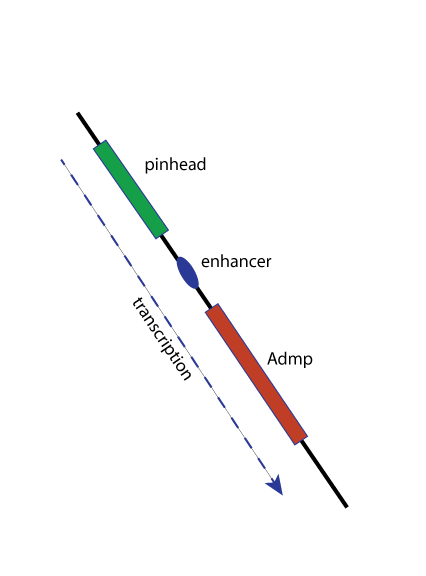Essay for April 2013: development of the Ciona tadpole
This month's essay is a brief summary of a research article in Science: "Cis-Acting Transcriptiona Repression Establishes a Sharp Boundary in Cordate Embryos"[1].
Background
The article is about the development of dorso-ventral patterning, the process of converting a symmetrical very early embryo into one with a different morphology on the dorsal as opposed to the ventral half. The process is assumed to due to differential gene expression in cells in the two halves; since all cells have the same collection of genes (the genome), the difference must be in expression of those genes.
Transcription is the process of reading DNA to make RNA, which is the actual template for production of the protein. Repression has it's normal meaning, and cis-acting means it is implimented by a DNA sequence on the same DNA next to the gene being repressed (as contrasted to trans, implimentation by molecules produced on another strand of DNA that diffuse to the site of repression). The ""sharp boundary" refers to the boundary between dorsal and ventral morphology.
As is typical of most contemporary science, this paper builds on a very considerable body of knowledge. Thus a large part of the work needed to understand the research results in a fundamental way is knowledge of what is already been described in the literature. A review of the literature in this field would require almost a book in itself, thus here we have to be satisfied with just a fragment.
The genes
Genes and their products are often named after their function, in this paper a central gene is bone morphogenetic protein (BMP). The name BMP was assigned when the gene was originally described, however, it’s function in this paper has no direct relation to bone development. Many genes have multiple functions, thus this situation is not unusual. In the second paragraph of the article the genes Bmp 2/4 are mentioned. These are two genes, Bmp 2 and Bmp 4, which as the names suggest are members of a family. Almost all genes are members of families, due to the major mechanism for creating new genes: gene duplication followed by mutation of one of the copies to serve a related but different purpose [LOTD pg 136].
The second gene mentioned in the article is anti-dorsalizing morphogenic protein, Admp. From it’s name we know that the protein produce by this gene inhibits the creation of dorsal morphology. As stated in the abstract, the Admp protein is a ligand of BMP, i.e. it binds to it. It is this binding it inhibits the activity of BMP.
The third gene mentioned is pinhead, named because defects in the gene cause zebrafish (the animal in which it was first studied) to have small heads. It is not unusual for genes to have whimsical names. In the Ciona tadpole, the pinhead protein is an antagonist for Admp.
Results
The work described in this article show that transcription of the pinhead gene inhibits transcription of Admp. However, it was previously known that Admp transcription induces pinhead transcription. Thus the sequence of events is: Admp transcription is present at the start of development (inhibiting Bmp activity), Admp transcription initiates pinhead transcription, pinhead transcription turns off Admp transcription, Bmp transcription is then initiated.. This type of system is called a flip-flop circuit in the electronics field, and is a basic building block for computers. By itself this story is only a part of the process by which the dorsal and ventral halves of the Ciona tadpole become differentiated. We learn the complete system piece by piece.
[1] Cis-acting Transcriptional Repression Extablishes a Sharp Boundary in Chordate Embryos. Imai, KS, et al., Science vol 337, pg 964 (2012) http://www.sciencemag.org/content/337/6097/964.abstract Unfortunately this article is not "open access", so you must have a subscription to Science, or access to a library that has one, or wait 6 months after the publication date to get access to the entire contents.
